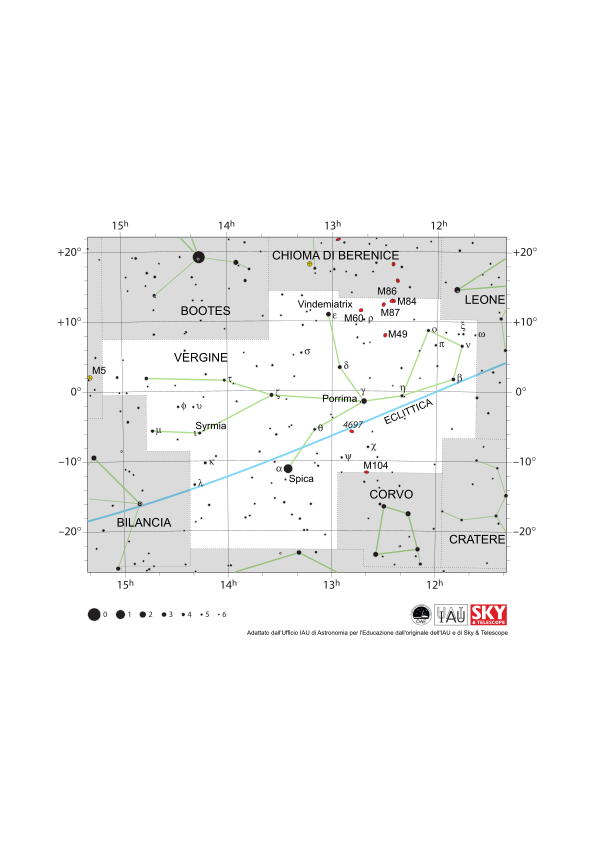This page describes an image Mappa della Costellazione della Vergine
Scarica il file PDF (PDF file 203.93 kB)
Diagram caption:
La costellazione zodiacale della Vergine e le costellazioni circostanti. Partendo dall'alto del diagramma e procedendo in senso orario, queste sono Chioma di Berenice, Leone, Cratere, Corvo, Bilancia e Bootes. La stella più luminosa della Vergine, Spica, si trova appena al di sotto dell'eclittica (qui rappresentata da una linea blu), al centro della mappa. Un modo per individuare questa stella nel cielo notturno è seguire il manico dell'Orsa Maggiore fino alla stella Arturo in Bootes e percorrere una linea retta fino a Spica ("arco per Arturo e picco per Spica"). Questa stella si trova appena sotto l'eclittica. L'eclittica è il percorso che il Sole compie nel cielo nel corso di un anno. Il Sole si trova in Vergine da metà settembre a fine ottobre. Gli altri pianeti del Sistema solare si trovano spesso in Vergine.
La Vergine si estende sull'equatore celeste e quindi una parte di essa è visibile in un certo periodo dell'anno da tutto il pianeta Terra, con una parte della costellazione oscurata nelle regioni più artiche e antartiche del mondo. La Vergine è maggiormente visibile la sera nella primavera dell'emisfero settentrionale e nell'autunno dell'emisfero meridionale.
La costellazione della Vergine appare come una persona sdraiata con la schiena approssimativamente contro l'eclittica, le braccia distese e i piedi puntati verso est. Nella Vergine sono visibili diversi oggetti del cielo profondo, tra cui NGC4697, M49, M87, M86, M84 e M60, tutti etichettati come ellissi rosse sulla mappa. Sono tutte galassie a spirale ed ellittiche situate a diversi milioni di anni luce dalla Terra. In particolare, M87 ospita il buco nero super massiccio (Pōwehi) che è stato fotografato dal telescopio Event Horizon nel 2019. Tutte queste galassie fanno parte dell'Ammasso della Vergine, l'ammasso di galassie più vicino alla Via Lattea.
L'asse y di questo diagramma è in gradi di declinazione con il nord in alto e l'asse x è in ore di ascensione retta con l'est a sinistra. Le dimensioni delle stelle qui segnate si riferiscono alla magnitudine apparente della stella, una misura della sua luminosità apparente. I punti più grandi rappresentano le stelle più luminose. Le lettere greche indicano le stelle più luminose della costellazione. Queste sono classificate in base alla luminosità: la stella più luminosa è etichettata come alfa, la seconda più luminosa come beta e così via, anche se questo ordine non è sempre rispettato esattamente. Le linee tratteggiate delimitano i confini delle costellazioni stabiliti dall'IAU e le linee verdi continue indicano una delle forme comuni utilizzate per rappresentare le figure delle costellazioni. Né i confini delle costellazioni né le linee che uniscono le stelle appaiono in cielo.
Diagram credit: Adattato dall'Ufficio IAU di Astronomia per l'educazione dall'originale di IAU/Sky & Telescope. Link per i Crediti
Stato di traduzione del Diagramma: Non ancora approvato da un revisore
Traduttori del Diagramma: Giuliana Giobbi
Termini di glossario connessi:
Ammasso di galassie
, Ascensione retta (RA)
, Bilancia
, Buco nero supermassiccio
, Coordinate celesti
, Costellazione
, Declinazione
, Eclittica
, Galassia a spirale
, Galassia ellittica
, Grande Carro
, Leone
, Magnitudine apparente
, Vergine
, Zodiaco
Categorie:
Astronomia ad occhio nudo
Diagram license: Creative Commons Attribuzione 4.0 Internazionale (CC BY 4.0) Creative Commons Attribuzione 4.0 Internazionale (CC BY 4.0) icone
In Altre Lingue
Inglese: Virgo Constellation MapSpagnolo: Mapa de la constelación de Virgo
Cinese tradizionale: 室女座星圖
Cinese semplificato: 室女座星图
Se noti un errore in questo diagramma, o nella sua didascalia, per favore contattaci.









